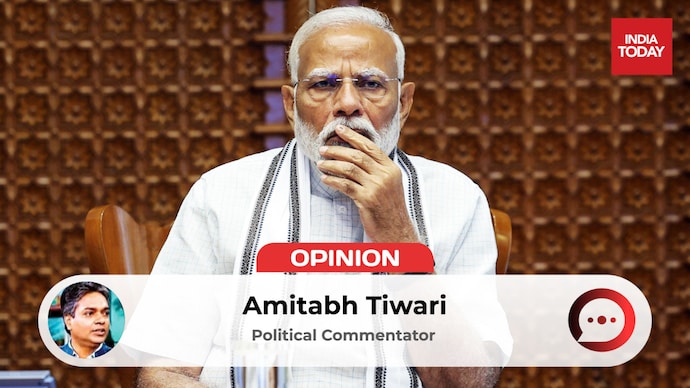This election is a classic case study of how the Opposition, which looked disunited and unprepared, could mount such a huge challenge.

How could a leader of Narendra Modi’s popularity, who boasted the BJP crossing 370 seats, not take BJP past the halfway mark? (Photo: PTI/India Today)
On June 4, the Bharatiya Janata Party, projected to gain a resounding mandate by pollsters, pundits, and the party itself, failed to make a simple majority in the Lok Sabha. It fell short by 32 seats, winning only 240 seats this time — a loss of 63 seats compared to 2019. The National Democratic Alliance won 293 seats. On the other hand, the Opposition, INDIA, did much better than initially expected.
The 2024 verdict ushered India back into the coalition era. The BJP now will have to keep in humour its two key allies, the Janata Dal (United)’s Nitish Kumar and the Telugu Desam Party’s N Chandrababu Naidu.
How could a leader of Narendra Modi’s popularity, who boasted the BJP crossing 370 seats, not take BJP past the halfway mark? This election is a classic case study of how the Opposition, which looked disunited and unprepared, could mount such a huge challenge.
Gains and losses
The BJP had maxed out in the northern and western parts of India, winning 81 and 65 per cent of the seats respectively in 2019. Its allies won 14 and 23 per cent respectively in these regions. The saffron party expected losses in Rajasthan, Madhya Pradesh, Chhattisgarh, Gujarat, Himachal Pradesh, Uttarakhand, Delhi, Bihar, Maharashtra, Karnataka, and Jharkhand either because of maxing out or because of the fierce challenge posed by the Opposition.
The BJP hoped to make up for these losses in West Bengal and Odisha in the east, Telangana and Andhra Pradesh in the south, and Uttar Pradesh in the north. It hoped to recoup these seats riding on the inauguration of the Ram Mandir in Ayodhya. The Prime Minister also ran a spirited campaign in Tamil Nadu and Kerala in hopes of opening the BJP’s accounts in these southern states.
In 2014 as well, the BJP had maxed out in north and west India. In 2019, it lost 34 or 12 per cent of the 282 seats it had won in 2014, including seats reallocated to allies. These as well could be attributed to maxing out and can be classified as natural losses.
These were compensated majorly by the 55 seats it gained primarily in West Bengal (+16), Odisha (+7), Karnataka (+8), Haryana (3), and Telangana (3). Going by the 2019 trend, the BJP should have lost 12 per cent of its 303-seat tally in 2024, that is 37 seats, which could then be compensated by other states mentioned above. Worst case scenario, even with no gains, it would then have landed 266 seats, which is close to a majority.
But the BJP lost 86 seats, almost 50 more than it should have lost going by the 2014-19 trend. It should have gained 20 per cent of seats of the base tally of 303, which is around 60 seats. However, it gained only 23 new seats, less than half. Instead of gaining seats from target states UP and West Bengal, it lost seats there, compounding the problem.
The party won 12 seats in Odisha (in simultaneous polls where it won the Vidhan Sabha polls as well), four in Telangana at the expense of the Bharat Rashtra Samithi, and three in Andhra Pradesh, piggybacking ally TDP’s performance in state elections, which it won handsomely.
In terms of losses, the biggest loss of 29 seats came from UP, including the Ayodhya seat (Faizabad). In Bengal, the BJP lost six seats to a feisty Mamata Banerjee. In Haryana, it lost five seats to Jat anger. In Bihar, it lost five seats to a resurrected Opposition. In Maharashtra, it lost a whopping 14 seats as voters rejected the BJP’s jod-tod politics. In Rajasthan, it lost 10 seats due to Rajput anger and ticket mismanagement. In Karnataka, it lost eight seats because of the Siddaramaiah government’s welfare policies. In Jharkhand, it lost three seats due to sympathy generated for Hemant Soren after his arrest.
In terms of vote share, the party lost massive vote share (-5 per cent and more) in UP, Haryana, Jharkhand, Karnataka, Manipur, and Rajasthan, while gaining in Telangana and Andhra Pradesh. In 2014, BJP won 25 per cent of its tally from UP, and in 2019, 20 per cent. In 2024, the corresponding number was just 14 per cent. If the party had maintained its tally in UP, it would have won 269 seats (3 short of majority).
BJP-Congress fights
In 2019, the BJP won 175 of the 190 direct contest seats against the Congress, a strike rate of 92 per cent. The Congress won only 15. In 2024, the direct contests increased to 215. These seats were majorly in UP, Telangana, Maharashtra etc. Of these, the BJP won 153 (-22), a strike rate of 71 per cent. The Congress 62 (+47).
This had a direct bearing on the results, with Congress almost doubling its tally to 99 (+47) and pulling down the BJP tally below the majority mark.
(Views expressed in this opinion piece are those of the author)
Published On:
Jun 8, 2024
Tune In













 English (US) ·
English (US) ·